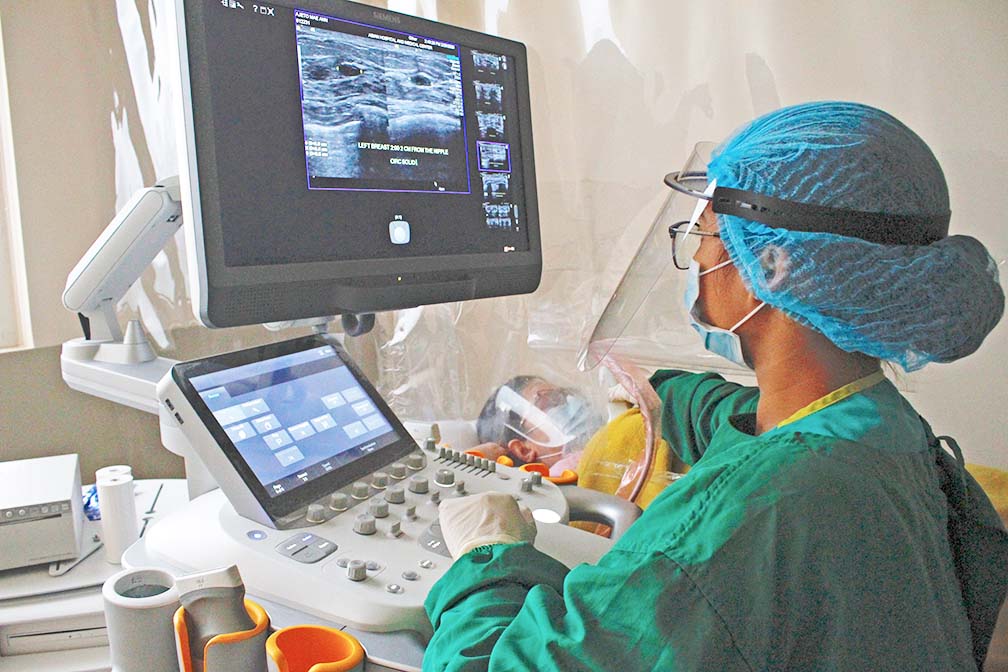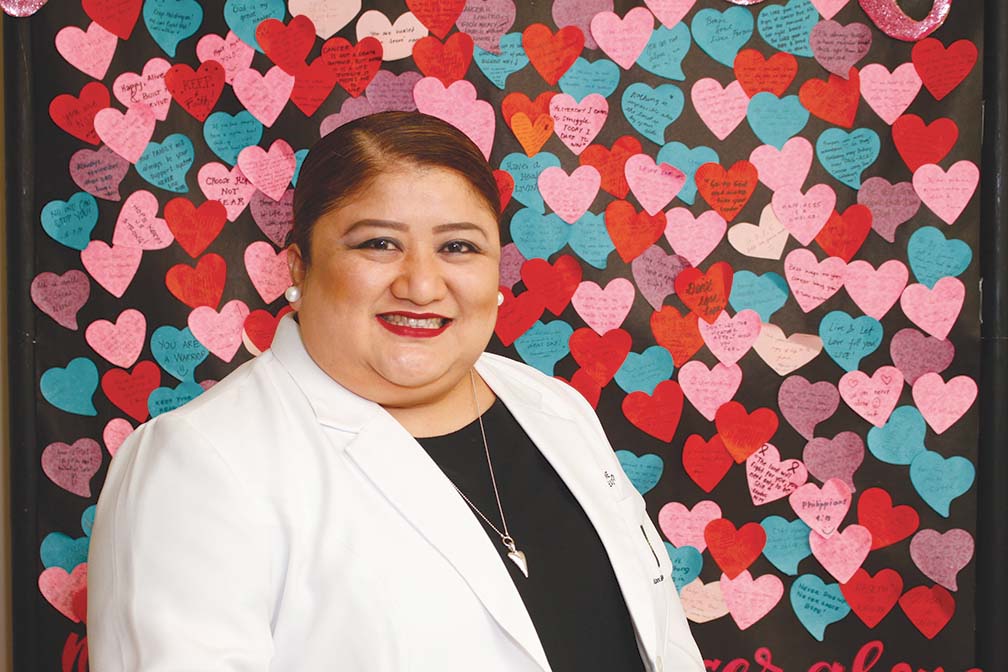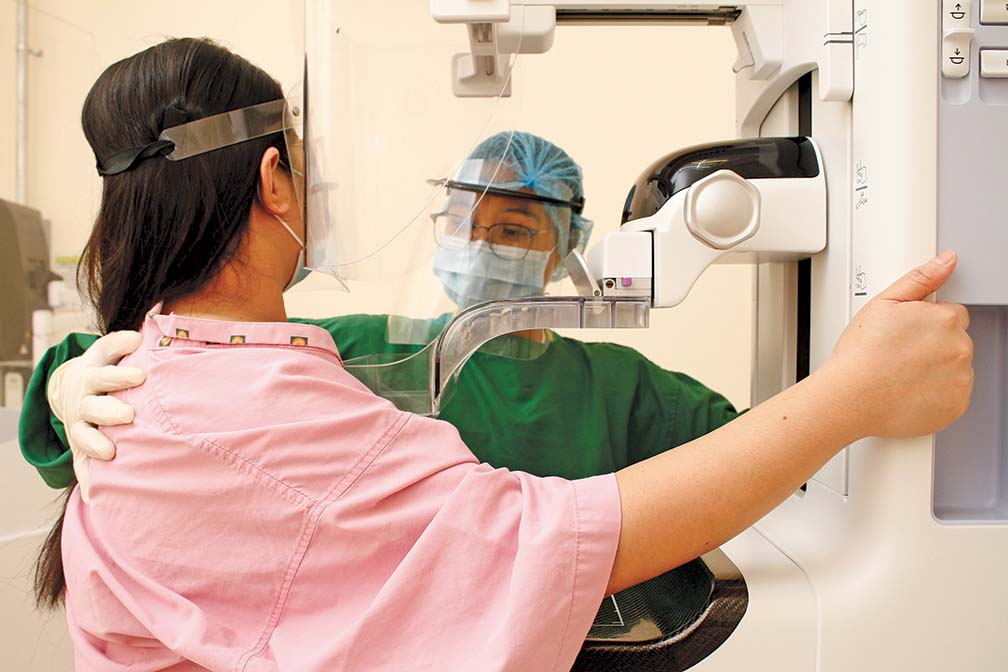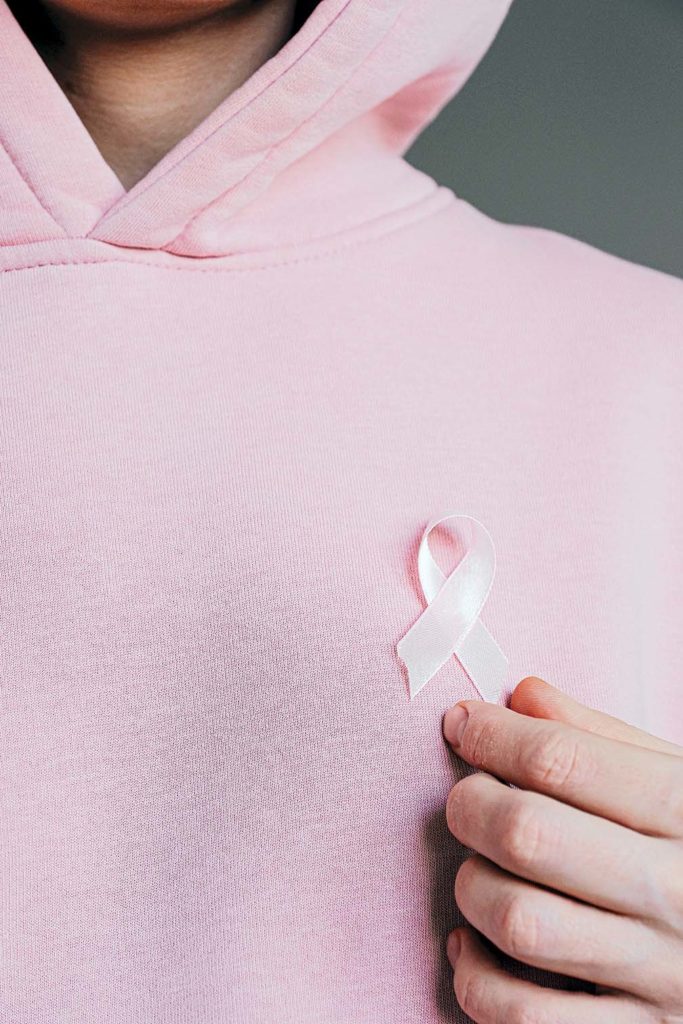Photos by Bernard Testa
When the entire island of Luzon was placed under Enhanced Community Quarantine (ECQ) back in mid-March, a number of women failed to go to the hospital to consult with their doctor and undergo screening for breast cancer even if they already had issues with their breasts. They did not want to go to the hospital for fear of contracting COVID-19.
With the easing up of quarantine restrictions, these women were finally able to have their breast screening and check-up. Unfortunately, the cancer in these women were diagnosed to already be in the advanced stages. The tumors were too big to be operated on and some of them even have cuts and wounds on their breasts.
“I don’t have the numbers but the majority of the patients that we see now are like that. This means that the cancer is so big that we have to do chemotherapy first before operating on it,” related Dr. Aldine Basa, Head of the Breast Center of Asian Hospital and Medical Center. “It has actually been quite devastating.”
According to the World Health Organization (WHO), breast cancer is the most frequent cancer among women, affecting 2.1 million women each year. It also causes the greatest number of cancer-related deaths among women. In 2018, it is estimated that 627,000 women died from breast cancer, approximately 15% of all cancer deaths among women. While breast cancer rates are higher among women in more developed regions, rates are increasing in nearly every region locally.

GLOBAL INCIDENCE
WHO added that the global incidence of breast cancer has tremendously risen by 256% over the last 30 years, with South East Asia increased by 479%. Breast cancer is the leading killer of women ages 35 to 54 worldwide while more than a million women develop breast cancer without knowing it and almost 300,000 die from it every year.
In the Philippines, the WHO recorded 24,794 new breast cancer cases with 8,057 deaths caused by breast cancer in 2018. The Philippine Cancer Network noted that one out of 13 Filipino women will develop breast cancer in her lifetime. It is also important to note that the Philippines has the highest incidence rate of breast caner in Asia and registered the highest increase of 589% among 187 countries over a 30-year period from 1980 to 2010.
With their existing breast cancer patients, Dr. Basa noted that in addition to constant follow ups with them by phone, their patients have been religiously going to the hospital for their check- ups and chemotherapy sessions.

“A lot of our patients are more afraid of their cancer than COVID-19 so if I tell them that they need this for their cancer, generally it has been easy and you do not need to convince them. They will come to the hospital. They will find a way,” said Dr. Basa.
CELLS IN THE BREAST
According to MayoClinic.Org, breast cancer is cancer that forms in the cells of the breasts. Signs and symptoms of breast cancer may include:
• A breast lump or thickening that feels different from the surrounding tissue;
• Change in the size, shape or appearance of a breast
• Changes to the skin over the breast, such as dimpling
• A newly inverted nipple
• Peeling, scaling, crusting or flaking of the pigmented area of the skin surrounding the nipple (areola) or breast skin; and
• Redness or pitting of the skin over your breast, like the skin of your orange.
Dr. Basa noticed that most of the women they are seeing at Asian Hospital right now are those with a concern “like they felt a lump, or they feel pain.”
“They want to see a doctor about it. They will come to the hospital for the screening. Women who do not feel anything or who just need to go for their routine mammogram or ultrasound will not go to us at this time,” Dr. Basa said.
She advised women to examine their breasts every month and if they feel anything, they should immediately see a doctor. For women who are menstruating, self-breast examination should be done on the 7th to 10th day of their menstruation. Women who are menopausal, on the other hand, can do this any time of the month.
“It is very hard to describe what is an alarming mass and what isn’t so what we usually advice is so long as you feel a mass, something that wasn’t there before, see the doctor and we will be the ones to determine what kind of mass it is,” Dr. Basa said.
NIPPLE DISCHARGE

Other signs to look out for are “discharge from the nipple, something that is wrong with the skin, that it has thickened or it has dimpling, an unusual enlargement of one breast which wasn’t like that before, the retraction of the nipple, which was not like that before. These are signs that should trigger you to see a doctor,” she said.
A woman who has issues with her breasts will consult a doctor who will perform a clinical breast exam. This is the examination of both breasts performed by a trained doctor. After this, the woman will be told to undergo screening which usually involves a mammogram and breast ultrasound.
A mammogram, according to MayoClinic.Org, is an X-ray of the breast. If an abnormality is detected on a screened mammogram, the doctor may recommend a diagnostic mammogram to further evaluate that abnormality.
The breast ultrasound makes use of sound waves to produce images of structures keep within the body. Ultrasound may also be used to determine whether a new breast lump is a solid mass or a fluid-filled cyst.
“What we have done at Asian Hospital is that we have scheduled all the screening procedures so you cannot just walk in. There is a limit to the number of patients that we do in a day to also control the exposure of the radiologists because they are the ones who are doing the ultrasound on the patients,” Dr. Basa explained.
PATIENTS WITH CONCERNS
While the Breast Center was handling 40 to 50 patients a day before the pandemic, they now handle only 16 a day. Dr. Basa explained that the 40 to 50 patients that they used to handle include those who are doing their routine check-up.
“They don’t feel anything and they are just undergoing screening. But what we are notcing now, for the 16 that we are doing, they are usually women who feel something, not necessarily a lump but they feel pain, they are concerned about something and they are the ones who are willing to undergo the screening procedure even if we are in a pandemic,” she said.
As stated earlier, if the mass found in the breast was too large, doctors would have no other option but to recommend chemotherapy first before operating on it. The usual practice is to remove the mass first before undergoing chemotherapy.
“The message remains the same. All women should be aware of their breasts. You should do your part which is examining your breast every month and you should still go for your mammogram and ultrasound,” Dr. Basa said.
She reiterated that all the necessary measures have been put in place “to control and contain the virus and make it safe for people to come in and consult.”
“I don’t think women should be afraid to have their mammograms and ultrasound because this is still something that can happen even if there is a pandemic so we should still be going for our mammograms and ultrasound for all women starting 40 years old and you should be doing it yearly. You can delay it this year but you should do it,” Dr. Basa said.
October is Breast Cancer Awareness Month and this is a good time to remind women not to delay their health concerns, especially when it comes to their breasts. As Dr. Basa said, this is a disease that is there whether there is a pandemic or not.
How to self-examine your breasts

Women should self-examine their breasts at least once a month. According to Breastcancer.org, there are five steps in self-examining your breasts:
Step 1:
Start by looking at your breasts in the mirror with your shoulders straight and your arms on your hips. You should look for the following:
• Breasts that are their usual size, shape and color
• Breasts that are evenly shaped without visible distortion or swelling.
Inform your doctor if you notice any of the following changes:
• Dimpling, puckering or bulging of the skin
• A nipple that has changed position or an inverted nipple (a nipple that has been pushed in instead of sticking out)
• Redness, soreness, rash or swelling
Step 2:
Next, raise your arms and look for the same changes
Step 3:
While you are still standing in front of the mirror, look for any signs of fluid coming out of one or both nipples (this could be watery, milky or yellow fluid or blood).
Step 4:
Next, feel your breasts while lying down using your right hand to feel your left breast and then your left hand to feel your right breast. Use a firm, smooth touch with the first few fingers of your hand, keeping the fingers flat and together. Use a circular motion about the size of a P1 coin.
Cover the entire breast from top to bottom, side to side – from your collarbone to the top of your abdomen, and from your armpit to your cleavage.
Follow a pattern to be sure that you cover the entire breast. You can begin at the nipple, moving in larger and larger circles until you reach the outer edge of the breast. You can also move your fingers up and down and vertically, in rows, as if you were mowing a lawn. This up and down approach seems to work best for most women.
Be sure to feel all the tissue from the front to the back of your breasts, for the skin and tissue just beneath, use light pressure; use medium pressure for tissue in the middle of your breasts; use firm pressure for the deep tissue in the back. When you’ve reached the deep tissue, you should be able to feel down to your ribcage.
Step 5:
Finally, feel your breasts while you are standing or sitting. Many women find that the easiest way to feel their breasts is when their skin is wet and slippery, so they like to do this step in the shower. Cover your entire breast, using the same hand movement described in Step 4.
If you find any questionable mass in your breast, do not panic. Make an appointment to see your doctor at the soonest possible time.
Source: https://www.breastcancer.org/symptoms/testing/types/self_exam




